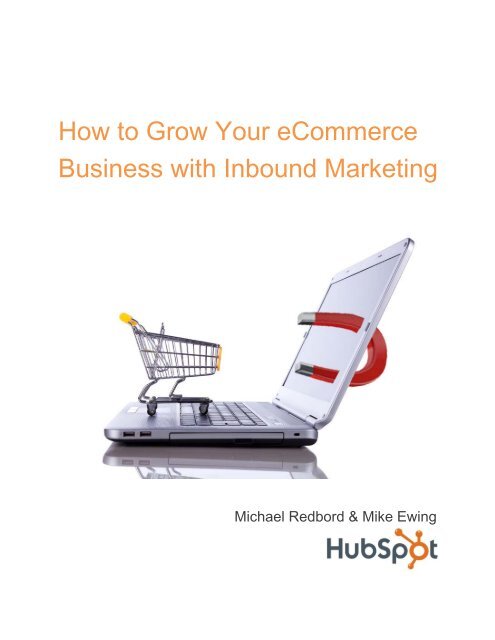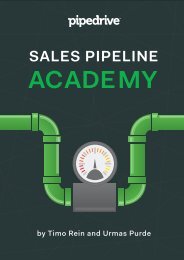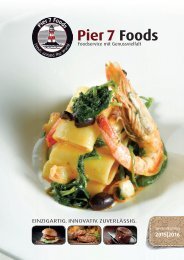How to Grow your eCommerce Business with Inbound Marketing
How to Grow your eCommerce Business with Inbound Marketing
How to Grow your eCommerce Business with Inbound Marketing
Create successful ePaper yourself
Turn your PDF publications into a flip-book with our unique Google optimized e-Paper software.
<strong>How</strong> <strong>to</strong> <strong>Grow</strong> Your <strong>eCommerce</strong><br />
<strong>Business</strong> <strong>with</strong> <strong>Inbound</strong> <strong>Marketing</strong><br />
Michael Redbord & Mike Ewing
ii<br />
<strong>How</strong> <strong>to</strong> <strong>Grow</strong> <strong>your</strong> <strong>eCommerce</strong> <strong>Business</strong> <strong>with</strong> <strong>Inbound</strong> <strong>Marketing</strong><br />
<strong>eCommerce</strong> <strong>Inbound</strong> <strong>Marketing</strong> is:<br />
1. Getting found online by creating remarkable<br />
content<br />
2. Converting traffic in<strong>to</strong> transactions and remarketable<br />
leads<br />
3. Measuring <strong>your</strong> marketing and sales data <strong>to</strong> grow<br />
<strong>your</strong> business<br />
Tweet this eBook!
Contents<br />
<strong>How</strong> <strong>Inbound</strong> <strong>Marketing</strong> Can Help <strong>eCommerce</strong> <strong>Business</strong>es ........................................................2<br />
Build interaction and visibility for more traffic ...................................................... 2<br />
Capture more email addresses for more sales ....................................................... 2<br />
Measure traffic and funnel yield........................................................................ 3<br />
<strong>Grow</strong>ing the Sales & <strong>Marketing</strong> <strong>eCommerce</strong> Funnel....................................................................4<br />
The <strong>eCommerce</strong> marketing funnel ..................................................................... 4<br />
What is an <strong>eCommerce</strong> lead?............................................................................ 4<br />
<strong>How</strong> <strong>to</strong> Make Your Products and S<strong>to</strong>re More Visible....................................................................6<br />
Utilize marketplaces and data feeds................................................................... 6<br />
Convert marketplace cus<strong>to</strong>mers in<strong>to</strong> cus<strong>to</strong>mers of <strong>your</strong> website ................................. 7<br />
SEO for <strong>eCommerce</strong> Product Pages ............................................................................................8<br />
Develop a uniform and clean website structure ..................................................... 8<br />
Create unique product titles ............................................................................ 8<br />
Go beyond the manufacturer’s description, <strong>to</strong>o ..................................................... 9<br />
Create <strong>your</strong> own optimized images ................................................................... 10<br />
Use heading tags ......................................................................................... 11<br />
Optimize internal anchor text ......................................................................... 11<br />
Include secondary navigation for all internal pages................................................ 11<br />
<strong>How</strong> <strong>to</strong> Blog for <strong>eCommerce</strong>.......................................................................................................12<br />
What <strong>to</strong> write about ..................................................................................... 12<br />
Make <strong>your</strong> content remarkable ........................................................................ 12<br />
Don’t over-think it ....................................................................................... 13<br />
Engage users <strong>with</strong> <strong>your</strong> brand and products ......................................................... 13<br />
Leveraging Social Media for <strong>eCommerce</strong>...................................................................................15<br />
Follow in <strong>your</strong> cus<strong>to</strong>mers’ footsteps .................................................................. 15<br />
Secure <strong>your</strong> social media accounts.................................................................... 15<br />
Listen and respond....................................................................................... 16<br />
Convert social media traffic in<strong>to</strong> leads............................................................... 17<br />
Moni<strong>to</strong>r the competition ................................................................................ 17<br />
Capture Visi<strong>to</strong>r Information Sooner for More Sales Later ...........................................................18<br />
Create calls <strong>to</strong> action that drive traffic and transactions ......................................... 18<br />
Landing pages that convert............................................................................. 19<br />
Email nurturing campaigns that drive repeat traffic ............................................... 20<br />
Measure and Optimize Traffic Sources.......................................................................................23<br />
Attributing purchases <strong>to</strong> traffic sources.............................................................. 23<br />
Cart abandonments ...................................................................................... 23<br />
Analyze and repeat successes.......................................................................... 25<br />
Get Started <strong>with</strong> <strong>Inbound</strong> <strong>Marketing</strong> ...........................................................................................26<br />
<strong>How</strong> HubSpot Can Help..............................................................................................................27<br />
Additional resources & footnotes ................................................................................................28
2<br />
<strong>How</strong> <strong>to</strong> <strong>Grow</strong> <strong>your</strong> <strong>eCommerce</strong> <strong>Business</strong> <strong>with</strong> <strong>Inbound</strong> <strong>Marketing</strong><br />
<strong>How</strong> <strong>Inbound</strong> <strong>Marketing</strong> Can Help<br />
<strong>eCommerce</strong> <strong>Business</strong>es<br />
<strong>Inbound</strong> <strong>Marketing</strong> is the practice of creating remarkable content <strong>to</strong> attract more<br />
potential consumers <strong>to</strong> <strong>your</strong> website, and converting them in<strong>to</strong> cus<strong>to</strong>mers through<br />
remarketing and reengagement.<br />
Over the course of this eBook, you will learn specific inbound marketing methodologies<br />
that will help you grow <strong>your</strong> <strong>eCommerce</strong> business. This ebook surveys the basics of<br />
inbound marketing: getting found, converting, and analyzing traffic and sales <strong>to</strong> grow<br />
<strong>your</strong> business.<br />
Build interaction and visibility for more traffic<br />
An increase in new and repeat visi<strong>to</strong>rs <strong>to</strong> <strong>your</strong> site will allow <strong>your</strong> products <strong>to</strong> be in front<br />
of more people more often, generating additional sales for <strong>your</strong> s<strong>to</strong>re. <strong>eCommerce</strong><br />
businesses understand this principle well, and apply it daily <strong>with</strong> a traffic acquisition<br />
strategy that drives sales.<br />
Think about <strong>your</strong> site and the pages on it. Does it include content beyond product<br />
pages? <strong>How</strong> much of <strong>your</strong> content is unique <strong>to</strong> <strong>your</strong> site? Do you blog? By employing<br />
unique content creation as a foundational piece of <strong>your</strong> marketing strategy, you create<br />
powerful assets <strong>to</strong> attract more consumers at different stages in the buying process.<br />
Unique, remarkable content that is relevant <strong>to</strong> <strong>your</strong> products and buyers will turn <strong>your</strong><br />
site in<strong>to</strong> a magnet for people researching, comparing, and purchasing <strong>your</strong> products.<br />
This vision of a site’s content as a magnet for traffic is the central pillar <strong>to</strong> inbound<br />
marketing.<br />
Capture more email addresses for more sales<br />
<strong>Inbound</strong> marketing provides mechanisms <strong>to</strong> create value for site visi<strong>to</strong>rs earlier in the<br />
buying process. As the buying process evolves from research <strong>to</strong> purchase, you want<br />
<strong>your</strong> s<strong>to</strong>re <strong>to</strong> be in front of consumers as often as possible.<br />
If you can capture consumer email addresses early in the buying process while using<br />
effective remarketing techniques, <strong>your</strong> s<strong>to</strong>re will be <strong>to</strong>p-of-mind when the consumer is<br />
ready <strong>to</strong> buy. A key principle of inbound marketing is <strong>to</strong> present visi<strong>to</strong>rs who are not yet<br />
Tweet this eBook!
3<br />
<strong>How</strong> <strong>to</strong> <strong>Grow</strong> <strong>your</strong> <strong>eCommerce</strong> <strong>Business</strong> <strong>with</strong> <strong>Inbound</strong> <strong>Marketing</strong><br />
ready <strong>to</strong> buy <strong>with</strong> powerful content and offers that help inform their future purchase<br />
decisions.<br />
With this structure in place, visi<strong>to</strong>rs provide their name and email in return for offers,<br />
generating marketable leads for <strong>your</strong> business and helping them reach a purchase<br />
decision <strong>with</strong> information from <strong>your</strong> s<strong>to</strong>re. <strong>How</strong> do you market <strong>to</strong> non-cus<strong>to</strong>mers <strong>to</strong>day?<br />
If someone comes <strong>to</strong> <strong>your</strong> site and doesn’t purchase, what <strong>to</strong>ols do you have <strong>to</strong> capture<br />
a future purchase? <strong>eCommerce</strong> inbound marketing offers a critical competitive<br />
advantage in visi<strong>to</strong>r capture and remarketing.<br />
Measure traffic and funnel yield<br />
If you are able <strong>to</strong> get in front of the right consumers more frequently, capture visi<strong>to</strong>r<br />
information earlier in the process, and nurture visi<strong>to</strong>rs appropriately, you can better<br />
understand the long-term value of every visit and unique visi<strong>to</strong>r. Additionally, you can<br />
retain and grow traffic better through improved site interaction and remarketing <strong>to</strong> drive<br />
increased sales over time.<br />
Do you measure traffic from all sources? Do you attribute each channel’s sales <strong>to</strong><br />
specific marketing efforts? By examining the entire process that creates a sale, you will<br />
understand which marketing events contributed <strong>to</strong> the sale. Implementing effective<br />
remarketing techniques, optimizing spend across multiple traffic channels, and<br />
measuring success of each campaign allows you <strong>to</strong> refine every step of the sales<br />
process.<br />
Tweet this eBook!
4<br />
<strong>How</strong> <strong>to</strong> <strong>Grow</strong> <strong>your</strong> <strong>eCommerce</strong> <strong>Business</strong> <strong>with</strong> <strong>Inbound</strong> <strong>Marketing</strong><br />
<strong>Grow</strong>ing the Sales & <strong>Marketing</strong><br />
<strong>eCommerce</strong> Funnel<br />
The <strong>eCommerce</strong> marketing funnel<br />
<strong>Inbound</strong> marketing helps businesses fill the <strong>to</strong>p of the sales and marketing funnel. It<br />
also helps <strong>to</strong> convert more website visi<strong>to</strong>rs in<strong>to</strong> leads, cus<strong>to</strong>mers, and finally repeat<br />
cus<strong>to</strong>mers. 1 <strong>Inbound</strong> marketing takes the existing <strong>eCommerce</strong> transaction funnel and<br />
amplifies its effectiveness at each stage of the sales process.<br />
What is an <strong>eCommerce</strong> lead?<br />
A “lead” is a core concept of inbound marketing, and often is an unfamiliar term for<br />
<strong>eCommerce</strong> businesses. Strictly speaking, a lead refers <strong>to</strong> a site visi<strong>to</strong>r who submits her<br />
name and contact information <strong>to</strong> <strong>your</strong> site. A lead is anyone who signs up for a<br />
newsletter, registers <strong>with</strong> <strong>your</strong> site, or is on <strong>your</strong> email list. Some leads have purchased<br />
from you in the past, but all are potential future cus<strong>to</strong>mers – new or repeat.<br />
The beauty of leads is that you can market <strong>to</strong> them. Because these cus<strong>to</strong>mers have<br />
submitted their email addresses, you can send them promotions, product updates and<br />
newsletters. 2 Leads driven by inbound marketing are unique because they represent<br />
someone who has come <strong>to</strong> <strong>your</strong> site for information. These prospects are looking for a<br />
good reason <strong>to</strong> buy in the future, and <strong>your</strong> remarketing can provide them <strong>with</strong> one.<br />
There are three types of leads that <strong>eCommerce</strong> sites should be concerned <strong>with</strong>:<br />
• Transacted Leads – Visi<strong>to</strong>rs who have landed on <strong>your</strong> site and purchased a<br />
product. Why, then, are they called a lead if they have already purchased? These<br />
are (hopefully) happy cus<strong>to</strong>mers who can be retained for repeat business.<br />
<strong>Marketing</strong> efforts <strong>to</strong> this group largely revolve around information and special<br />
offers that lead <strong>to</strong> additional transactions in the future. Based on their previous<br />
purchase, you can make educated decisions about other products they may be<br />
interested in.<br />
Tweet this eBook!
5<br />
<strong>How</strong> <strong>to</strong> <strong>Grow</strong> <strong>your</strong> <strong>eCommerce</strong> <strong>Business</strong> <strong>with</strong> <strong>Inbound</strong> <strong>Marketing</strong><br />
• Non-Transacted Product Leads – Visi<strong>to</strong>rs who have selected a product and<br />
have begun the checkout process. They have registered for an account or at<br />
least provided their email address but did not complete the full transaction.<br />
<strong>Marketing</strong> efforts <strong>to</strong> this group should encourage leads <strong>to</strong> complete the intended<br />
transaction in the near-term, and come back for additional transactions in the<br />
future.<br />
• Non-Transacted, Non-Product Leads – Visi<strong>to</strong>rs who have not yet made a<br />
transaction but have subscribed <strong>to</strong> <strong>your</strong> email newsletter or otherwise submitted<br />
their contact information <strong>to</strong> you. These leads are not yet ready <strong>to</strong> buy. They have,<br />
however, demonstrated interest in <strong>your</strong> products, brand, and services, and are<br />
excellent prospects for future sales.<br />
Tweet this eBook!
6<br />
<strong>How</strong> <strong>to</strong> <strong>Grow</strong> <strong>your</strong> <strong>eCommerce</strong> <strong>Business</strong> <strong>with</strong> <strong>Inbound</strong> <strong>Marketing</strong><br />
<strong>How</strong> <strong>to</strong> Make Your Products and S<strong>to</strong>re<br />
More Visible<br />
One of the primary inbound marketing growth strategies is <strong>to</strong> expand <strong>your</strong> reach – the<br />
<strong>to</strong>tal number of people who see <strong>your</strong> site’s content and products – <strong>to</strong> drive more visi<strong>to</strong>rs<br />
<strong>to</strong> <strong>your</strong> website. More traffic at the <strong>to</strong>p of <strong>your</strong> funnel leads <strong>to</strong> more transactions. And<br />
even if you were not <strong>to</strong> make changes <strong>to</strong> the middle of <strong>your</strong> funnel (product pages,<br />
landing pages, and remarketing), you would still generate more sales by attracting<br />
more, qualified traffic <strong>to</strong> <strong>your</strong> site.<br />
Utilize marketplaces and data feeds<br />
To sell more items, you need <strong>to</strong> make <strong>your</strong> products visible <strong>to</strong> more consumers. Feature<br />
<strong>your</strong> products in every marketplace that will 1) host <strong>your</strong> products and 2) provide<br />
additional reach for <strong>your</strong> products. Although each marketplace has its own unique<br />
considerations for <strong>your</strong> business, 3 more listings typically equate <strong>to</strong> more exposure and<br />
thus help boost sales.<br />
When listing <strong>your</strong> products in a marketplace, keep in mind:<br />
• Each marketplace requires separate attributes<br />
• Manually uploading products <strong>to</strong> multiple marketplaces is time consuming<br />
• Schedule au<strong>to</strong>mated XML data feeds <strong>to</strong> upload <strong>to</strong> marketplaces when possible 4<br />
• If creating an au<strong>to</strong>matic data feed is not financially or technically possible, create<br />
<strong>your</strong> own data feed and upload it on a regular basis<br />
Consider using au<strong>to</strong>mated data feeds whenever possible <strong>to</strong> reduce the time required <strong>to</strong><br />
list <strong>your</strong> products. This will reduce <strong>your</strong> investment of time and resources while still<br />
giving you the advantage of increased product exposure.<br />
Tweet this eBook!
7<br />
<strong>How</strong> <strong>to</strong> <strong>Grow</strong> <strong>your</strong> <strong>eCommerce</strong> <strong>Business</strong> <strong>with</strong> <strong>Inbound</strong> <strong>Marketing</strong><br />
Convert marketplace cus<strong>to</strong>mers in<strong>to</strong> cus<strong>to</strong>mers of<br />
<strong>your</strong> website<br />
After you have made a sale on a marketplace and paid fees <strong>to</strong> that marketplace for the<br />
sale, you should be focused on reconverting that cus<strong>to</strong>mer on another sale through <strong>your</strong><br />
website and not through the marketplace where you have <strong>to</strong> pay the additional fees.<br />
Here are a few ways in which you can convert marketplace traffic <strong>to</strong> s<strong>to</strong>refront traffic:<br />
• In <strong>your</strong> physical packaging, include time-sensitive promotional fliers <strong>with</strong> a short<br />
link <strong>to</strong> a unique landing page on <strong>your</strong> website 5<br />
• Adopt product prices on <strong>your</strong> website that are lower than the ones in<br />
marketplaces<br />
• Offer discounts for first-time cus<strong>to</strong>mers on <strong>your</strong> website<br />
• Offer coupons available for use on <strong>your</strong> website only<br />
• To the extent that each marketplace allows, use email lead nurturing campaigns<br />
that encourage visits <strong>to</strong> <strong>your</strong> site<br />
• Present discounts for certain existing cus<strong>to</strong>mers based on their previous buying<br />
behavior<br />
Marketplaces can be powerful cus<strong>to</strong>mer acquisition <strong>to</strong>ols <strong>to</strong> get <strong>your</strong> products in front of<br />
new consumers. 6 Before you invest, however, carefully consider whether the price of<br />
acquisition is worth the price of admission. Ensure that you take listing fees, actual<br />
shipping costs, product costs, taxes, and processing charges in<strong>to</strong> account when pricing<br />
<strong>your</strong> products. Then after a consumer first purchases from you on a marketplace, use<br />
remarketing strategies <strong>to</strong> turn those marketplace cus<strong>to</strong>mers in<strong>to</strong> repeat cus<strong>to</strong>mers on<br />
<strong>your</strong> website.<br />
Tweet this eBook!
8<br />
<strong>How</strong> <strong>to</strong> <strong>Grow</strong> <strong>your</strong> <strong>eCommerce</strong> <strong>Business</strong> <strong>with</strong> <strong>Inbound</strong> <strong>Marketing</strong><br />
SEO for <strong>eCommerce</strong> Product Pages<br />
Product pages need <strong>to</strong> be in front of potential buyers as often as possible. When<br />
optimized properly, <strong>your</strong> product pages themselves can greatly improve existing traffic<br />
opportunities.<br />
Develop a uniform and clean website structure<br />
A clear and easy-<strong>to</strong>-read URL structure makes understanding and categorizing <strong>your</strong><br />
pages easier for search engines as well as for humans. Organize product pages in this<br />
way:<br />
http://www.<strong>your</strong>s<strong>to</strong>re.com/productcategory/product<br />
And ensure that <strong>your</strong> blog is either located at:<br />
Instead of:<br />
http://blog.<strong>your</strong>s<strong>to</strong>re.com or http://www.<strong>your</strong>s<strong>to</strong>re.com/blog<br />
http://<strong>your</strong>s<strong>to</strong>re.wordpress.com or http://<strong>your</strong>s<strong>to</strong>re.blogspot.com<br />
This product structure makes sense <strong>to</strong> both search engines and people, and provides<br />
short but important in-URL elements for SEO. Hosting <strong>your</strong> blog on <strong>your</strong> own domain<br />
will generally improve <strong>your</strong> site’s ability <strong>to</strong> get found through search.<br />
Create unique product titles<br />
Search engines discount the value of duplicate content. If you are using the same<br />
product title as many other s<strong>to</strong>res online selling <strong>your</strong> same products, you will be outranked<br />
by higher authority competi<strong>to</strong>rs using the same content on their product pages.<br />
You can even be penalized for using the same copy as many other sites. 7<br />
Tweet this eBook!
9<br />
<strong>How</strong> <strong>to</strong> <strong>Grow</strong> <strong>your</strong> <strong>eCommerce</strong> <strong>Business</strong> <strong>with</strong> <strong>Inbound</strong> <strong>Marketing</strong><br />
To beat the competition, you will need <strong>to</strong> move beyond the manufacturers’ or<br />
distributers’ titles and descriptions and create unique product pages. Include relevant<br />
keywords in the title, and be careful of removing keywords that are frequently<br />
associated <strong>with</strong> the product. Add in keywords that differentiate the title and consumers<br />
would use in qualified search queries.<br />
Above, BlueFly uses descriptive page titles, URLs, and breadcrumbs for its products. It<br />
would have been easier for BlueFly <strong>to</strong> use a simple “Cole Haan black nylon jacket” title.<br />
Instead, the page title is more specific, differentiating this product page from other<br />
pages selling the same item.<br />
Potential cus<strong>to</strong>mers will still be searching for the basics of the product title, so you need<br />
<strong>to</strong> make <strong>your</strong>s just slightly different.<br />
Go beyond the manufacturer’s description, <strong>to</strong>o<br />
Smart inbound marketers do not just copy and paste the manufacturer’s description and<br />
images on<strong>to</strong> their product pages, either. Take the time <strong>to</strong> write <strong>your</strong> own titles, creative<br />
descriptions, and especially use <strong>your</strong> own images. If you want <strong>to</strong> stand apart from other<br />
s<strong>to</strong>res selling similar products, be unique, remarkable, and relevant. Both search<br />
engines and people will recognize <strong>your</strong> efforts.<br />
Tweet this eBook!
10 <strong>How</strong> <strong>to</strong> <strong>Grow</strong> <strong>your</strong> <strong>eCommerce</strong> <strong>Business</strong> <strong>with</strong> <strong>Inbound</strong> <strong>Marketing</strong><br />
Create <strong>your</strong> own optimized images<br />
Product images can be the most important feature of an <strong>eCommerce</strong> s<strong>to</strong>re and can<br />
make or break a sale. Naturally, people want <strong>to</strong> pick up and <strong>to</strong>uch something before<br />
they buy it. 8 To appeal <strong>to</strong> this impulse, capture product images from multiple angles and<br />
allow the user <strong>to</strong> zoom in on the image for a closer look. This will enhance the user<br />
experience and lead <strong>to</strong> building additional value and trust <strong>with</strong>in <strong>your</strong> s<strong>to</strong>re, an element<br />
critical <strong>to</strong> that “add-<strong>to</strong>-cart” click.<br />
Above, Zappos shows 7 different views of its product. None of the images are supplied<br />
by the manufacturer and all images are high enough quality <strong>to</strong> allow a high level of<br />
zoom. This helps consumers feel as though they understand the product better and is a<br />
distinct selling point for Zappos over competi<strong>to</strong>rs.<br />
In addition <strong>to</strong> adding multiple images, include an alt image tag <strong>to</strong> all the pictures of <strong>your</strong><br />
products. Search engines cannot read images, but they can read the alt attribute of an<br />
image on a page. The alt tag is a means of ensuring that people can find <strong>your</strong> images<br />
through image search engines like Google Images. If you use product-related alt text,<br />
you can get <strong>your</strong> products found through yet another avenue.<br />
Tweet this eBook!
11 <strong>How</strong> <strong>to</strong> <strong>Grow</strong> <strong>your</strong> <strong>eCommerce</strong> <strong>Business</strong> <strong>with</strong> <strong>Inbound</strong> <strong>Marketing</strong><br />
Use heading tags<br />
Your heading tag (H1 tag, starting <strong>with</strong> on a page) should reinforce <strong>your</strong> page title<br />
and product name. Search engines give significant importance <strong>to</strong> heading tags, so it is<br />
critical <strong>to</strong> use them whenever possible on every page – especially on product pages.<br />
Using an H1 tag <strong>to</strong> reinforce the keywords in <strong>your</strong> page titles creates a well-optimized<br />
page that is more easily found for a specific keyword combination.<br />
Optimize internal anchor text<br />
Use keyword-rich, specific anchor text when linking <strong>to</strong> pages <strong>with</strong>in <strong>your</strong> website. Use<br />
targeted keyword phrases as the anchor text for internal links, helping search engines<br />
understand the content available by following each link. By using good, relevant anchor<br />
text, more relevant content on <strong>your</strong> site will be surfaced and ranked higher.<br />
Include secondary navigation for all internal pages<br />
Secondary navigation, otherwise known as breadcrumbs, helps potential cus<strong>to</strong>mers<br />
navigate back <strong>to</strong> the main product category pages and other areas of interest. These<br />
also create useful anchor text for internal links. 9 See the BlueFly example above for a<br />
well-executed breadcrumb example.<br />
Tweet this eBook!
12 <strong>How</strong> <strong>to</strong> <strong>Grow</strong> <strong>your</strong> <strong>eCommerce</strong> <strong>Business</strong> <strong>with</strong> <strong>Inbound</strong> <strong>Marketing</strong><br />
<strong>How</strong> <strong>to</strong> Blog for <strong>eCommerce</strong><br />
After optimizing <strong>your</strong> existing content, how can you drive more traffic <strong>to</strong> <strong>your</strong> s<strong>to</strong>re<br />
outside of product and category pages?<br />
Most <strong>eCommerce</strong> businesses are familiar <strong>with</strong> paid methods of traffic generation. By<br />
creating unique, remarkable and valuable content you can supplement paid sources or<br />
augment existing non-paid traffic sources. 10 The most effective way <strong>to</strong> create this type<br />
of content on a regular basis is through a blog.<br />
What <strong>to</strong> write about<br />
Developing a <strong>to</strong>pic <strong>to</strong> write about consistently is an important decision. Develop a<br />
content strategy that does not just include only <strong>your</strong> products, but addresses <strong>your</strong><br />
industry and <strong>your</strong> cus<strong>to</strong>mers’ needs and interests. If you sell widgets, write about how<br />
widgets are used, new widgets features, and industry news about widgets. Avoid simply<br />
selling <strong>your</strong> products on the blog. Instead, consider how you can craft newsworthy<br />
s<strong>to</strong>ries relating <strong>to</strong> <strong>your</strong> widgets that people will find interesting and will want <strong>to</strong> share<br />
<strong>with</strong> their friends and colleagues.<br />
Make <strong>your</strong> content remarkable<br />
You can produce remarkable content by creating unique, creative, and valuable<br />
information. To this end, do not be afraid <strong>to</strong> experiment <strong>with</strong> other mediums like video<br />
and graphics on <strong>your</strong> blog. If writing text isn’t <strong>your</strong> strong point, definitely consider video<br />
or graphics as a way <strong>to</strong> write fewer words but still create highly shareable content.<br />
Video demonstrations are a spectacular way of both showcasing <strong>your</strong> products and<br />
creating remarkable content. In fact, simply using different marketing techniques than<br />
<strong>your</strong> competition can be a shortcut <strong>to</strong> content that people will want <strong>to</strong> find and share. 11<br />
Remarkable content attracts links from other websites pointing <strong>to</strong> <strong>your</strong> s<strong>to</strong>refront, <strong>to</strong>o.<br />
Each link is a double win: it leads <strong>to</strong> new traffic and builds up <strong>your</strong> site’s authority in the<br />
eyes of search engines.<br />
Tweet this eBook!
13 <strong>How</strong> <strong>to</strong> <strong>Grow</strong> <strong>your</strong> <strong>eCommerce</strong> <strong>Business</strong> <strong>with</strong> <strong>Inbound</strong> <strong>Marketing</strong><br />
Don’t over-think it<br />
Publishing regular content <strong>to</strong> <strong>your</strong> website will help drive more traffic <strong>to</strong> <strong>your</strong> site and<br />
s<strong>to</strong>re. To keep producing posts frequently, it’s important not <strong>to</strong> over-think or over-write<br />
each blog article. After all, the more traffic you drive <strong>to</strong> <strong>your</strong> site, the more conversion<br />
opportunities you create, so you want <strong>to</strong> get in<strong>to</strong> a habit of easy content creation that<br />
works for you.<br />
Although the length of each blog post length will vary, most blog posts should be<br />
between about 200 and 1000 words. 12 Keep in mind that the purpose of each piece of<br />
content is <strong>to</strong> attract traffic <strong>to</strong> <strong>your</strong> site, build <strong>your</strong> brand and get shared online. So while<br />
length isn’t always the most important aspect of a blog post, it is typically difficult <strong>to</strong><br />
create high-quality, text-only content in under 200 words unless there is a strong video<br />
or graphic element included.<br />
Engage users <strong>with</strong> <strong>your</strong> brand and products<br />
Create <strong>your</strong> own buyer community that wants <strong>to</strong> share relevant information across their<br />
network. Creating a content hub on <strong>your</strong> website provides an additional opportunity <strong>to</strong><br />
market <strong>your</strong> products and promotions. Use original content <strong>to</strong> bring in visi<strong>to</strong>rs that will<br />
grow in<strong>to</strong> qualified buyers in the long run.<br />
An <strong>eCommerce</strong> site <strong>with</strong> a strong community hub is Moosejaw.com. Moosejaw sells<br />
outdoor apparel and equipment online and their community page, called “Moosejaw<br />
Tweet this eBook!
14 <strong>How</strong> <strong>to</strong> <strong>Grow</strong> <strong>your</strong> <strong>eCommerce</strong> <strong>Business</strong> <strong>with</strong> <strong>Inbound</strong> <strong>Marketing</strong><br />
Madness”, centralizes Moosejaw’s content from around the web (e.g. Twitter, blog,<br />
Flickr), offers monthly contests, and even contains dating advice. This provides their<br />
fans multiple ways <strong>to</strong> interact <strong>with</strong> the brand, creating a vibrant non-transactional<br />
destination online that promotes future purchases <strong>with</strong> Moosejaw.<br />
Tweet this eBook!
15 <strong>How</strong> <strong>to</strong> <strong>Grow</strong> <strong>your</strong> <strong>eCommerce</strong> <strong>Business</strong> <strong>with</strong> <strong>Inbound</strong> <strong>Marketing</strong><br />
Leveraging Social Media for <strong>eCommerce</strong><br />
Chances are that <strong>your</strong> potential cus<strong>to</strong>mers — regardless of industry, age or gender —<br />
are active on social media networking sites. 13 You should take advantage of social<br />
media’s increased popularity and get involved in new conversations <strong>to</strong> expand <strong>your</strong><br />
visibility and reach.<br />
Follow in <strong>your</strong> cus<strong>to</strong>mers’ footsteps<br />
Your cus<strong>to</strong>mers are on social media searching for answers, opinions and suggestions<br />
on what <strong>to</strong> buy and from whom <strong>to</strong> buy. The chances that you will stumble across these<br />
relevant conversations randomly are quite low. Moni<strong>to</strong>ring conversations on social<br />
media in a strategic, targeted manner is necessary <strong>to</strong> engage efficiently and reduce the<br />
signal-<strong>to</strong>-noise ratio. Once you learn <strong>to</strong> listen, it’s time <strong>to</strong> speak up.<br />
Your primary goals on social networks should be <strong>to</strong> create brand awareness, observe<br />
the competition, build relationships, and convert social media traffic in<strong>to</strong> leads and<br />
cus<strong>to</strong>mers on <strong>your</strong> site. Begin <strong>with</strong> the mainstays —Twitter and Facebook — then start<br />
listening and searching for more niche 14 networks.<br />
Secure <strong>your</strong> social media accounts<br />
If you don’t know where <strong>to</strong> begin, try Facebook and Twitter. For each social media<br />
network that you want <strong>to</strong> interact on, however, do the following:<br />
• Set up an account and optimize <strong>your</strong> profile<br />
• Learn community rules, regulations, and culture<br />
• Search the community for brand mentions, competi<strong>to</strong>rs, and conversations<br />
concerning <strong>your</strong> products<br />
• Find <strong>to</strong>ols <strong>to</strong> utilize and engage <strong>with</strong> the selected social media network<br />
• Market exclusive, compelling offers <strong>to</strong> each community<br />
• Share unique, brand-building content that brings users <strong>to</strong> <strong>your</strong> site<br />
With any existing community, the largest barrier <strong>to</strong> entry is understanding how the<br />
community works and operating <strong>with</strong>in those bounds. <strong>Business</strong>es marketing in preexisting<br />
communities need <strong>to</strong> realize that they are no longer on their home turf, and may<br />
need <strong>to</strong> tread lightly <strong>with</strong>in community norms.<br />
Tweet this eBook!
16 <strong>How</strong> <strong>to</strong> <strong>Grow</strong> <strong>your</strong> <strong>eCommerce</strong> <strong>Business</strong> <strong>with</strong> <strong>Inbound</strong> <strong>Marketing</strong><br />
On BassResource.com, a bass fishing enthusiast forum and the first result on Google<br />
for “bass fishing forum”, active community members link <strong>to</strong> their s<strong>to</strong>res in signatures or<br />
posts. Because they are active and valued members of the community, these users’<br />
promotions are socially acceptable and a powerful magnet for highly qualified traffic.<br />
This is a common practice among marketers on community forums if (and only if!) the<br />
marketers first establish themselves as valuable community members and build the<br />
trust of the community prior <strong>to</strong> marketing actively. So interact first and promote later.<br />
Listen and respond<br />
People like <strong>to</strong> voice their problems on social networks because of the instant responses<br />
they receive. They use various platforms <strong>to</strong> collect advice, feedback, and<br />
recommendations – <strong>with</strong> many of these instances pertaining <strong>to</strong> specific products. Use<br />
this knowledge <strong>to</strong> create content that addresses these issues, later positioning <strong>your</strong><br />
product or cus<strong>to</strong>mer service team as a viable solution.<br />
A prime example of social media moni<strong>to</strong>ring aiding brand image and cus<strong>to</strong>mer service is<br />
Home Depot. Home Depot actively moni<strong>to</strong>rs Twitter for cus<strong>to</strong>mer complaints, questions,<br />
Tweet this eBook!
17 <strong>How</strong> <strong>to</strong> <strong>Grow</strong> <strong>your</strong> <strong>eCommerce</strong> <strong>Business</strong> <strong>with</strong> <strong>Inbound</strong> <strong>Marketing</strong><br />
and frustrations. See above for a quick response and positive cus<strong>to</strong>mer reaction<br />
between @homedepot and an unhappy s<strong>to</strong>re visi<strong>to</strong>r. Within 10 minutes of a relevant<br />
tweet, Home Depot responds and defuses a negative situation before it escalates.<br />
Moni<strong>to</strong>ring social media for brand conversations allows you <strong>to</strong> do the same.<br />
Convert social media traffic in<strong>to</strong> leads<br />
An important consideration <strong>with</strong>in social media is that the majority of <strong>your</strong> social media<br />
audience is not yet ready <strong>to</strong> purchase. Remember that these potential buyers are in<br />
conversational mode, not shopping mode, and respect this by offering them nontransactional<br />
ways <strong>to</strong> engage <strong>with</strong> <strong>your</strong> site. As a marketer, you can later re-engage<br />
them over email as well as social media.<br />
Promote landing pages on social media designed <strong>to</strong> collect their email address in<br />
exchange for a compelling offer such as “20% Off Future Order for Members Only” or<br />
“Download an Exclusive Twitter Product Catalog.” Then, continue <strong>to</strong> re-engage these<br />
new leads over time so that when they become sales-ready, they will purchase from<br />
<strong>your</strong> site and not <strong>your</strong> competi<strong>to</strong>r’s. 15<br />
Moni<strong>to</strong>r the competition<br />
Follow <strong>your</strong> competition on Twitter, friend their fan page on Facebook, become a fan of<br />
theirs on Yelp, subscribe <strong>to</strong> their blogs and special offers, and actively search for their<br />
involvement in and around the blogosphere. The goal is not <strong>to</strong> copy <strong>your</strong> competition,<br />
but pick out effective strategies and make them <strong>your</strong> own and engage in conversations<br />
that concern <strong>your</strong> products.<br />
Develop <strong>your</strong> own engagement approach and build <strong>your</strong> fan base; grow <strong>your</strong> reach by<br />
being better than <strong>your</strong> competi<strong>to</strong>rs.<br />
Tweet this eBook!
18 <strong>How</strong> <strong>to</strong> <strong>Grow</strong> <strong>your</strong> <strong>eCommerce</strong> <strong>Business</strong> <strong>with</strong> <strong>Inbound</strong> <strong>Marketing</strong><br />
Capture Visi<strong>to</strong>r Information Sooner for<br />
More Sales Later<br />
It is time <strong>to</strong> address the middle of the marketing funnel now that we’ve discussed best<br />
practices for traffic growth, content creation and product pages. Your site’s primary<br />
goals should not be solely focused on optimizing conversion and checkout processes,<br />
but should instead also focus on converting non purchasing site traffic in<strong>to</strong> marketable<br />
leads.<br />
Investing time in<strong>to</strong> developing a strategy for non-transactional offers is highly rewarding<br />
over the long term. The payoff is twofold. First, you will convert more of the site visi<strong>to</strong>rs<br />
you’re attracting in<strong>to</strong> leads. Secondly, you can remarket <strong>to</strong> these leads as you would <strong>to</strong><br />
an existing cus<strong>to</strong>mer. Strategies include using calls <strong>to</strong> action, landing pages and email<br />
marketing <strong>to</strong> nurture <strong>your</strong> leads down the funnel.<br />
Create calls <strong>to</strong> action that drive traffic and transactions<br />
A call <strong>to</strong> action is a but<strong>to</strong>n—literally, an image—used <strong>to</strong> capture interest and drive traffic<br />
<strong>to</strong> a specified page. A typical <strong>eCommerce</strong> call <strong>to</strong> action is “buy now” or “add <strong>to</strong> cart” or<br />
“checkout.” Think of where these calls <strong>to</strong> action are on <strong>your</strong> site <strong>to</strong>day, and consider<br />
their singular purpose: purchase.<br />
What about the other 98% of <strong>your</strong> site visi<strong>to</strong>rs who don’t purchase upon a visit? 16 Earlystage<br />
shoppers are in research mode, so capitalize on that mindset by placing but<strong>to</strong>ns<br />
in their path that speak <strong>to</strong> their research needs.<br />
A compelling call <strong>to</strong> action for these visi<strong>to</strong>rs might be “10 Things You Need <strong>to</strong> Know<br />
About Widgets” or “Download the Spring Widget Catalog” or “Ultimate Buyer’s Guide <strong>to</strong><br />
Widgets.” This is the sort of call <strong>to</strong> action that would interest and convert nontransacting<br />
visi<strong>to</strong>rs, the majority of <strong>your</strong> site traffic.<br />
Tweet this eBook!
19 <strong>How</strong> <strong>to</strong> <strong>Grow</strong> <strong>your</strong> <strong>eCommerce</strong> <strong>Business</strong> <strong>with</strong> <strong>Inbound</strong> <strong>Marketing</strong><br />
Above, a landing page from Fo<strong>to</strong>Bridge offers visi<strong>to</strong>rs two calls <strong>to</strong> action: one <strong>with</strong> “Buy<br />
Now” type messaging, and one <strong>with</strong> “Free Guide” type messaging. Note how the design<br />
differences of the two calls <strong>to</strong> action draw the eye <strong>to</strong> the “Buy Now” type but<strong>to</strong>n over the<br />
“Free Guide” type but<strong>to</strong>n, encouraging purchase-ready users <strong>to</strong> enter the product<br />
pages.<br />
Landing pages that convert<br />
Once a visi<strong>to</strong>r clicks on a “Free Guide” call <strong>to</strong> action but<strong>to</strong>n, they are taken <strong>to</strong> a landing<br />
page. This is a page <strong>with</strong> the singular purpose of getting visi<strong>to</strong>rs <strong>to</strong> fill out a form in<br />
return for something they already indicated they wanted (the guide). Remember that<br />
everyone who sees a landing page has already expressed interest in the page’s offer by<br />
having clicked <strong>to</strong> the page – the form just needs <strong>to</strong> complete the deal.<br />
Use the following best practices <strong>to</strong> maximize <strong>your</strong> landing page conversion rates:<br />
• Provide enough information for visi<strong>to</strong>rs <strong>to</strong> realize the value of the offer<br />
• Do not overwhelm the visi<strong>to</strong>r <strong>with</strong> text<br />
• Use bold text <strong>to</strong> highlight important information<br />
• Use pictures, video, or graphics <strong>to</strong> demonstrate the value of the offer<br />
• Keep the form short and only ask for necessary information<br />
• Remove site navigation <strong>to</strong> force the visi<strong>to</strong>r <strong>to</strong> either fill out the form or leave the<br />
page<br />
Tweet this eBook!
20 <strong>How</strong> <strong>to</strong> <strong>Grow</strong> <strong>your</strong> <strong>eCommerce</strong> <strong>Business</strong> <strong>with</strong> <strong>Inbound</strong> <strong>Marketing</strong><br />
• Redirect <strong>to</strong> a Thank-You page that fulfills on the offer and links back <strong>to</strong> product<br />
pages<br />
First-class landing pages <strong>with</strong> first-class offers can convert at 40%+. 17 These nontransactional<br />
leads represent critical pieces of visi<strong>to</strong>r information you’re leaving on the<br />
table unless you use value-added marketing offers like buyer’s guides, eBooks, and<br />
checklists on <strong>your</strong> site. These types of offers also tend <strong>to</strong> address a large portion of <strong>your</strong><br />
site’s traffic.<br />
Above, Newegg’s “Ultimate SupremeCombo Sweepstakes” offers a chance <strong>to</strong> win a<br />
$6,000 desk<strong>to</strong>p computer in return for personal information. Consider following suit by<br />
using attractive call <strong>to</strong> action but<strong>to</strong>ns linking <strong>to</strong> landing pages advertising sweepstakes,<br />
quizzes, and contents <strong>to</strong> expand their email lists.<br />
Email nurturing campaigns that drive repeat traffic<br />
Just as you would email a previous cus<strong>to</strong>mer about promotions and new offerings, you<br />
should remarket <strong>to</strong> visi<strong>to</strong>rs whom have expressed interest in <strong>your</strong> s<strong>to</strong>re or products but<br />
not yet purchased. Because each lead has opted in<strong>to</strong> <strong>your</strong> form and has given you their<br />
information, you have the right <strong>to</strong> remarket <strong>to</strong> them.<br />
Tweet this eBook!
21 <strong>How</strong> <strong>to</strong> <strong>Grow</strong> <strong>your</strong> <strong>eCommerce</strong> <strong>Business</strong> <strong>with</strong> <strong>Inbound</strong> <strong>Marketing</strong><br />
A campaign <strong>to</strong> nurture these leads through email should provide a few different reasons<br />
for the recipient <strong>to</strong> revisit <strong>your</strong> site. As you stay in communication <strong>with</strong> visi<strong>to</strong>rs by<br />
referring them <strong>to</strong> current promotions and product updates, you position <strong>your</strong> site as the<br />
preferred purchase destination. 18<br />
To increase the value of a non-transactional lead, email nurturing campaigns should:<br />
1. Present research-oriented shoppers <strong>with</strong> more information<br />
2. Push products or high-value free offers in the middle of <strong>your</strong> campaign<br />
3. Present coupons or discounts<br />
Consumers have an overwhelming number of buying choices, so it’s imperative <strong>to</strong> be<br />
<strong>to</strong>p of mind when they reach in<strong>to</strong> their wallets. Use lead nurturing campaigns that<br />
include a clear call <strong>to</strong> action that drives leads <strong>to</strong> <strong>your</strong> site while also being relevant <strong>to</strong><br />
their most recent conversion on <strong>your</strong> site. Your lead nurturing campaign should consist<br />
of multiple emails that last weeks and months, not days. 19<br />
Gilt Groupe, an online clothing merchant, sends segmented emails <strong>to</strong> its cus<strong>to</strong>mer base<br />
advertising new daily deals on a regular basis. The emails contain clear calls <strong>to</strong> action<br />
and highlight what their cus<strong>to</strong>mer base is most likely <strong>to</strong> buy through the use of color and<br />
imagery.<br />
Tweet this eBook!
22 <strong>How</strong> <strong>to</strong> <strong>Grow</strong> <strong>your</strong> <strong>eCommerce</strong> <strong>Business</strong> <strong>with</strong> <strong>Inbound</strong> <strong>Marketing</strong><br />
Tweet this eBook!
23 <strong>How</strong> <strong>to</strong> <strong>Grow</strong> <strong>your</strong> <strong>eCommerce</strong> <strong>Business</strong> <strong>with</strong> <strong>Inbound</strong> <strong>Marketing</strong><br />
Measure and Optimize Traffic Sources<br />
Your website traffic should consist of more than one source, so you need <strong>to</strong> measure<br />
each visit and transaction for proper analysis. Track ROI on campaigns, terms, and lists<br />
when measuring PPC campaigns. Compare organic vs. paid traffic, social media vs.<br />
direct, and weigh which channel you should be investing in most on a regular basis.<br />
Your investment of time and money in traffic acquisition should be based on the sources<br />
bringing you the most transactions.<br />
Attributing purchases <strong>to</strong> traffic sources<br />
Attributing a purchase <strong>to</strong> one, final visit is flawed. 20 Instead, capture early-stage leads,<br />
extract their information, and attribute their eventual purchase based on that prior<br />
engagement <strong>with</strong> <strong>your</strong> site. This adds intelligence <strong>to</strong> an otherwise opaque process of<br />
attributing purchases <strong>to</strong> just the final traffic source. This can help answer questions like:<br />
• Are <strong>your</strong> PPC dollars on high-volume terms pulling in unqualified buyers, or just<br />
early-stage shoppers who return later <strong>to</strong> buy?<br />
• If a visi<strong>to</strong>r purchased via paid search, but originally engaged via organic search,<br />
should you be investing more in content?<br />
• Does social media traffic eventually translate in<strong>to</strong> revenue?<br />
If you are able <strong>to</strong> capture visi<strong>to</strong>r information earlier in the process while nurturing visi<strong>to</strong>rs<br />
appropriately, you can better understand the long-term value of each traffic channel.<br />
This, in turn, allows for better adjustments <strong>to</strong> <strong>your</strong> marketing efforts. The key, though, is<br />
<strong>to</strong> measure traffic by the early signals of buying intent given by a visi<strong>to</strong>r - and a website<br />
hit isn't enough, and a purchase is <strong>to</strong>o late.<br />
Cart abandonments<br />
<strong>eCommerce</strong> sites lose a high percentage of interested shoppers in the checkout<br />
process. 21 In between submitting an email address and the final checkout page, most<br />
<strong>eCommerce</strong> sites lose about half of their potential buyers. If we re-envision these cart<br />
abandonments as "leads" instead of "visi<strong>to</strong>rs who did not purchase," we open up a wide<br />
array of opportunities.<br />
Tweet this eBook!
24 <strong>How</strong> <strong>to</strong> <strong>Grow</strong> <strong>your</strong> <strong>eCommerce</strong> <strong>Business</strong> <strong>with</strong> <strong>Inbound</strong> <strong>Marketing</strong><br />
Here is a new way <strong>to</strong> think about cart abandonment and convert abandoned carts in<strong>to</strong><br />
sales:<br />
• Cart abandoners have demonstrated the highest possible level of buying intent<br />
<strong>with</strong>out actually purchasing<br />
• In many cases, carts are abandoned for reasons unrelated <strong>to</strong> not wanting <strong>to</strong><br />
purchase the product 22<br />
• The near-term potential value of a cart abandonment is large and measurable<br />
• You've already captured their name and email; reach out <strong>to</strong> them and make an<br />
offer they can't resist<br />
Cart abandonment campaigns that include a quick email <strong>with</strong> messaging like "you left<br />
this in <strong>your</strong> cart, we'll hold it for 24 hours" can work well for visi<strong>to</strong>rs who abandoned<br />
accidentally or just need a subtle reminder. Offers of free shipping, a few dollars off, or<br />
extra loyalty points can help price-sensitive visi<strong>to</strong>rs purchase.<br />
These are just two of the many ways in which you can convert visi<strong>to</strong>rs who abandon<br />
carts in<strong>to</strong> paying cus<strong>to</strong>mers. An analytics system that measures visi<strong>to</strong>rs, cart<br />
abandonments as leads, and cus<strong>to</strong>mers is the prerequisite <strong>to</strong> successful cart nurturing.<br />
Tweet this eBook!
25 <strong>How</strong> <strong>to</strong> <strong>Grow</strong> <strong>your</strong> <strong>eCommerce</strong> <strong>Business</strong> <strong>with</strong> <strong>Inbound</strong> <strong>Marketing</strong><br />
On the prior page, Williams-Sonoma sends an email saying, “This is a friendly reminder<br />
that you may have items saved in <strong>your</strong> Shopping Basket and <strong>your</strong> basket will expire<br />
soon. Have product or ordering questions? Call our Cus<strong>to</strong>mer Care Center…" This is an<br />
example of a company utilizing cart abandonments <strong>to</strong> their advantage, reminding the<br />
cus<strong>to</strong>mer <strong>to</strong> purchase the product and offering <strong>to</strong> answer question through a direct<br />
channel.<br />
Analyze and repeat successes<br />
Whether using email remarketing, tweaking the checkout process, or optimizing product<br />
pages, you can always tie these changes back <strong>to</strong> actual revenue and determine<br />
revenue-based ROI on <strong>your</strong> tweaks. The same methodology applies for high-level traffic<br />
sources or non-transacting leads.<br />
The goal of any change <strong>to</strong> <strong>your</strong> <strong>eCommerce</strong> site is <strong>to</strong> grow incremental revenue through<br />
proven methods. Identifying fac<strong>to</strong>rs that contribute <strong>to</strong> revenue and investing in the most<br />
successful ones will grow <strong>your</strong> bot<strong>to</strong>m line: do more of what works and less of what<br />
doesn’t. By regularly analyzing every piece of <strong>your</strong> marketing and sales process, you<br />
can rapidly reduce <strong>your</strong> cost of cus<strong>to</strong>mer acquisition.<br />
Tweet this eBook!
26 <strong>How</strong> <strong>to</strong> <strong>Grow</strong> <strong>your</strong> <strong>eCommerce</strong> <strong>Business</strong> <strong>with</strong> <strong>Inbound</strong> <strong>Marketing</strong><br />
Get Started <strong>with</strong> <strong>Inbound</strong> <strong>Marketing</strong><br />
This eBook has defined inbound marketing for <strong>eCommerce</strong> best practices. Ready <strong>to</strong> get<br />
started? See the below checklist for a condensed version <strong>with</strong> actionable steps:<br />
1. Make Remarkable Product Pages. Product pages are the most important<br />
element of <strong>your</strong> s<strong>to</strong>refront. Make sure that they are both unique and remarkable.<br />
2. Improve S<strong>to</strong>re Visibility. Utilize marketplaces and social media <strong>to</strong> expand <strong>your</strong><br />
reach of potential buyers.<br />
3. Use Lead Nurturing <strong>to</strong> lower marketplace fees and cus<strong>to</strong>mer acquisition costs<br />
by sending timely emails enticing marketplace cus<strong>to</strong>mers <strong>to</strong> purchase from <strong>your</strong><br />
s<strong>to</strong>re.<br />
4. Start a blog. And remember: the blogging platform you choose is much less<br />
important than the content you produce. Write content people want <strong>to</strong> read 2-3<br />
times a week.<br />
5. Create an offer that doesn't require a credit card. This can be a newsletter,<br />
buyer's guide, checklist, or tip sheet. Make it compelling and helpful.<br />
6. Put <strong>your</strong> offer on a landing page. Keep the page’s form short and collect visi<strong>to</strong>r<br />
information for remarketing <strong>to</strong> visi<strong>to</strong>rs who are not yet ready <strong>to</strong> purchase.<br />
7. Link <strong>to</strong> <strong>your</strong> landing page. Link <strong>to</strong> <strong>your</strong> offer <strong>with</strong> a call-<strong>to</strong>-action but<strong>to</strong>n. Help<br />
buyers who aren’t ready <strong>to</strong> purchase find useful information and grow <strong>your</strong> email<br />
list of non-transacted leads.<br />
8. Optimize <strong>your</strong> upper funnel. Reduce friction in <strong>your</strong> buying funnel. Remember<br />
that a purchase doesn't always happen on the first visit, and use methods <strong>to</strong><br />
remarket <strong>to</strong> non-transacting traffic.<br />
9. Configure a cart abandonment campaign. This campaign remarkets <strong>to</strong> a traffic<br />
segment <strong>with</strong> extremely high value. Offer reminders and incentives they simply<br />
can't refuse.<br />
10. Track everything and attribute leads and cus<strong>to</strong>mers <strong>to</strong> their original traffic<br />
source. Actively analyze this data <strong>to</strong> reduce <strong>your</strong> cost of cus<strong>to</strong>mer acquisition.<br />
Tweet this eBook!
27 <strong>How</strong> <strong>to</strong> <strong>Grow</strong> <strong>your</strong> <strong>eCommerce</strong> <strong>Business</strong> <strong>with</strong> <strong>Inbound</strong> <strong>Marketing</strong><br />
<strong>How</strong> HubSpot Can Help<br />
HubSpot offers a simple, integrated marketing platform <strong>to</strong> make <strong>your</strong> <strong>eCommerce</strong><br />
business work hard for you. With HubSpot’s <strong>to</strong>ols and education, you can easily identify<br />
what needs <strong>to</strong> be done <strong>to</strong> make <strong>your</strong> <strong>eCommerce</strong> site work as well as it can. Each of<br />
our cus<strong>to</strong>mers is paired <strong>with</strong> an <strong>Inbound</strong> <strong>Marketing</strong> Consultant <strong>to</strong> make sure you get off<br />
<strong>to</strong> a fast start, and we put an <strong>Inbound</strong> <strong>Marketing</strong> Education in<strong>to</strong> <strong>your</strong> hands so you have<br />
the knowledge you need <strong>to</strong> be successful.<br />
Tracking and Improving SEO: HubSpot’s Keyword Grader allows you <strong>to</strong> manage<br />
terms that are important <strong>to</strong> <strong>your</strong> business. With HubSpot’s Difficulty measurement, you<br />
can determine which keywords and phrases drive traffic and identify which keywords<br />
you can rank for in search engines. HubSpot’s Page Grader and Link Grader also offer<br />
specific SEO suggestions that will improve <strong>your</strong> visibility.<br />
Blogging for <strong>Business</strong> and Content Creation: HubSpot’s blogging platform allows<br />
you <strong>to</strong> easily create content that is optimized <strong>to</strong> help you get found online, grow <strong>your</strong><br />
organic keyword footprint, attract valuable inbound links and differentiate <strong>your</strong>self from<br />
the competitive pack.<br />
Tracking Cus<strong>to</strong>mer Happiness and Protecting <strong>your</strong> Brand: HubSpot’s Social Media<br />
Moni<strong>to</strong>ring Tool helps you track real-time conversations about <strong>your</strong> brand and products,<br />
enabling you <strong>to</strong> easily respond <strong>to</strong> both positive and negative conversations on the Web.<br />
<strong>Grow</strong> traffic and leads <strong>with</strong> content creation based real consumer issues and interests.<br />
Capture More Visi<strong>to</strong>r Information <strong>to</strong> <strong>Grow</strong> Your Email List: HubSpot’s landing page<br />
<strong>to</strong>ol and wizard help you create landing pages in minutes. Bring in those nontransactional<br />
leads quickly and easily while testing the effectiveness of different landing<br />
page types <strong>to</strong> increase conversions.<br />
Follow up on Visi<strong>to</strong>rs and Cus<strong>to</strong>mers <strong>to</strong> Nurture Future Purchases: HubSpot’s lead<br />
nurturing and email remarketing <strong>to</strong>ols give you what you need <strong>to</strong> keep cus<strong>to</strong>mers and<br />
prospects informed of specials, product updates and newsletters. With the HubSpot<br />
API, you can au<strong>to</strong>matically nurture abandoned shopping carts. Tailor <strong>your</strong> marketing<br />
offers and you will increase the probability of reconversions and sales.<br />
Track, Measure, and Repeat the <strong>Marketing</strong> Activities That Bring in Money:<br />
HubSpot’s closed loop marketing analytics give you instant insights in<strong>to</strong> <strong>your</strong> business<br />
process <strong>with</strong>out having <strong>to</strong> dig through piles of data. Determine which marketing<br />
initiatives bring in the most sales and eliminate what’s ineffective.<br />
<strong>How</strong> <strong>to</strong> Get Started: Simply contact <strong>your</strong> HubSpot <strong>Inbound</strong> <strong>Marketing</strong> Specialist<br />
<strong>to</strong>day <strong>to</strong> find out more. Visit http://www.hubspot.com/inbound-marketingassessment-product/<br />
or call 888-HUBSPOT.<br />
Tweet this eBook!
28 <strong>How</strong> <strong>to</strong> <strong>Grow</strong> <strong>your</strong> <strong>eCommerce</strong> <strong>Business</strong> <strong>with</strong> <strong>Inbound</strong> <strong>Marketing</strong><br />
Additional resources & footnotes<br />
1<br />
For specific case studies of how inbound marketing helps businesses grow, see HubSpot’s case<br />
studies:<br />
http://www.hubspot.com/cus<strong>to</strong>mer-case-studies/<br />
2<br />
Depending on <strong>your</strong> privacy policy, this may require minor changes for full CAN-SPAM compliance. Learn<br />
more<br />
at See Why’s Blog: http://seewhy.com/blog/2010/10/20/email-remarketing-compliance/<br />
3For<br />
a mostly complete listing of marketplaces and their fee structures, see <strong>eCommerce</strong> Optimization’s<br />
“ Shopping Portals and Product Listing Guide” athttp://www.ecommerceoptimization.com/comparison<br />
shopping-listing-guide/<br />
4<br />
For more information on XML data feeds, see Google’s “Data Feed Instructions” at<br />
h ttp://base.google.com/support/bin/answer.py?answer=59537&hl=en.<br />
For a how-<strong>to</strong> specifically on Google<br />
Product Search, see http://www.youtube.com/watch?v=eGf-c617ugk<br />
5In<br />
an April 2009 <strong>Marketing</strong>Sherpa survey of 1,481 ecommerce businesses, 43% responded that “Limited<br />
time/limited inven<strong>to</strong>ry promotions” were “very effective” (the highest effectiveness rating of offered<br />
choices). See chart in “Tactics that do (and don’t) work <strong>to</strong>day”<br />
athttp://www.marketingexperiments.com/improving-website-conversion/optimizing-<strong>your</strong>-ecommerce site.html<br />
6<br />
“eBay’s own data on sellers which have opened shops claims that the average sellers see an increase<br />
in sales of around 1 quarter (25%). Depending on the market sec<strong>to</strong>r you are in the increase in traffic can<br />
rise<br />
by 100s if not 1000s of potential buyers all looking for <strong>your</strong> items.” From Duncan Beech at eZine at<br />
h ttp://ezinearticles.com/?9-Reasons-<strong>to</strong>-Open-an-eBay-Shop&id=4952627<br />
7<br />
“The end result is that product <strong>with</strong> duplicate content will never rank as well in Google's search engine as<br />
a unique page. This is not a penalty, merely the natural consequence of an overlooked problem.” From<br />
Practical<br />
<strong>eCommerce</strong>, “SEO: The Duplicate Content Penalty” at<br />
h ttp://www.practicalecommerce.com/articles/444-SEO-The-Duplicate-Content-Penalty<br />
8<br />
“Without the ability <strong>to</strong> <strong>to</strong>uch, hold, smell, taste or otherwise handle the products they are interested in,<br />
potential cus<strong>to</strong>mers have only images <strong>to</strong> interact <strong>with</strong>. Ultimately, the softer, tastier, flashier and more<br />
attractive <strong>your</strong> products look <strong>to</strong> shoppers, the more confident they’ll feel about purchasing from you and<br />
the better <strong>your</strong> conversion rate will be.” From Smashing Magazine, “Improve Your E-Commerce Design<br />
With Brilliant Product Pho<strong>to</strong>s” at http://www.smashingmagazine.com/2010/08/24/improve-<strong>your</strong>-ecommerce-design-<strong>with</strong>-brilliant-product-pho<strong>to</strong>s/<br />
9<br />
“As a highly cost- and time-effective way of helping <strong>to</strong> reduce abandonment rates and prevent consumer<br />
disorientation, breadcrumbs are a standard navigational element on a vast majority of <strong>to</strong>day’s successful<br />
<strong>eCommerce</strong><br />
sites...” From “Happy Trails: Benefits & Implementation of Breadcrumbs” at<br />
h ttp://www.blueacorn.com/blog/ecommerce-usability/ecommerce-breadcrumbs/<br />
10<br />
For more information, see HubSpot’s blogging kit at http://www.hubspot.com/blogging-kit/. For a related<br />
case study, see http://www.hubspot.com/cus<strong>to</strong>mer-case-studies/bid/5753/Pool-Construction-Company-<br />
Reduces-PPC-Spending-50-<strong>Grow</strong>s-Organic-Leads<br />
11<br />
For a notable example, see the BlendTec Will It Blend? Viral Video Case Study by SociaLens<br />
athttp://www.socialens.com/wp-content/uploads/2009/04/20090127_case_blendtec11.pdf<br />
12 [A]verage blog readers stay 96 seconds per blog…the general opinion seems <strong>to</strong> be that a page of at<br />
least 250 words are probably a reasonable length. Similarly, many advise keeping pages under 1000<br />
Tweet this eBook!
29 <strong>How</strong> <strong>to</strong> <strong>Grow</strong> <strong>your</strong> <strong>eCommerce</strong> <strong>Business</strong> <strong>with</strong> <strong>Inbound</strong> <strong>Marketing</strong><br />
words.” From Problogger.net, “Post Length – <strong>How</strong> Long Should a Blog Post Be?” at<br />
h ttp://www.problogger.net/archives/2006/02/18/post-length-how-long-should-a-blog-post-be/<br />
13“People<br />
are 67% more likely <strong>to</strong> purchase products from brands they follow on Twitter and 51% more<br />
likely <strong>to</strong> do so if they follow a brand on Facebook.” From “Study: People who follow brands in social<br />
media are much more likely <strong>to</strong> shop <strong>with</strong> them in the real world” at http://econsultancy.com/us/blog/5609study-twitter-and-facebook-boost-sales<br />
14<br />
For an up-<strong>to</strong>-date list, see Wikipedia’s “List of Social Networking Websites” at<br />
h ttp://en.wikipedia.org/wiki/List_of_social_networking_websites<br />
15<br />
“Social media traffic does not want the offer. At least not the offer you are interested in selling. They<br />
think that the offer is in the way of the deal. When they trust you, then they will come <strong>to</strong> <strong>your</strong> page for that<br />
offer through a brand search. If you only highlight <strong>your</strong> offer, then you will be stuck <strong>with</strong> only a fraction of<br />
the value you could generate from the users you receive from social media traffic.” From “Top 5<br />
Misconceptions About <strong>How</strong> Social Media Traffic Converts” at http://jesperastrom.com/socialconversion/<strong>to</strong>p-5-misconceptions-about-how-social-media-traffic-converts/<br />
16A<br />
recent study conducted by Forrester as presented in an article from the August 2007 edition of Target<br />
<strong>Marketing</strong> Magazine. The article stated, “Forrester research indicates that the average conversion rate –<br />
that is the ratio of orders <strong>to</strong> overall site visits – is 2.9 percent.” From Search <strong>Marketing</strong> Standard’s “What<br />
is the average conversion rate?” at http://www.searchmarketingstandard.com/what-is-the-averageconversion-rate/comment-page-1<br />
17<br />
Internal HubSpot.com data, 2006-2010<br />
18<br />
“Today's best <strong>to</strong>ol for retention is still a generous, creative, and smartly segmented email program.<br />
That's been the case since the dawn of ecommerce, and some 89% of merchants still say email is their<br />
highest-ROI<br />
channel.” From Timberline Interactive’s “5 Powerful Tactics for <strong>eCommerce</strong>” at<br />
h ttp://blog.timberlineinteractive.com/post/5-Powerful-Tactics-for-<strong>eCommerce</strong>.aspx<br />
19<br />
From Search Engine Land’s “Everybody Deserves A Second Chance” at<br />
http://searchengineland.com/everybody-deserves-a-second-chance-using-remarketing-<strong>to</strong>-reach-<br />
abandoned-shoppers-2-42609<br />
20<br />
“As ecommerce marketers strive <strong>to</strong> get the best return for every dollar they invest, there is a danger that<br />
they will fall prey <strong>to</strong> the last click effect, attributing all of a campaign's success <strong>to</strong> just the last interaction a<br />
cus<strong>to</strong>mer has before arriving on site or making a purchase.” From “<strong>eCommerce</strong> Know-<strong>How</strong>: Avoid the<br />
Last Click Effect” at http://www.practicalecommerce.com/articles/1307-<strong>eCommerce</strong>-Know-<strong>How</strong>-Avoid-<br />
The-Last-Click-Effect<br />
21<br />
“Online shopping carts are abandoned at a high rate of 56.2 percent. The report also indicates that<br />
using remarketing techniques, such as triggered emails <strong>to</strong> remind users of their uncompleted transaction<br />
can result in more than 20 times the transaction rates, compared <strong>to</strong> sending standard bulk emails. From<br />
<strong>eCommerce</strong> Guide’s “A Buyer’s Guide <strong>to</strong> Remarketing Services” at http://www.ecommerceguide.com/solutions/advertising/article.php/3886596/A-Buyers-Guide-<strong>to</strong>-Remarketing-Services.htm<br />
and<br />
Experian’s “The Remarketing Report” at http://www.experian.com/assets/marketing-services/whitepapers/EMS_remarketing_WP.pdf<br />
22 48% of cart abandonment is caused by using shopping cart for research or for reasons other than<br />
product price. From “Understanding the Causes of Shopping Cart Abandonment” at<br />
http://onlinebusiness.volusion.com/articles/understanding-the-causes-of-shopping-cart-abandonment<br />
Tweet this eBook!

















